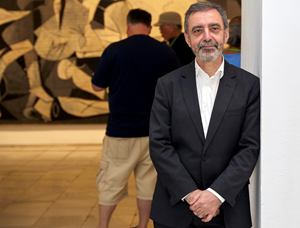
The director of the Reina Sofia Museum, Manuel Borja-Villel, leaves the institution after 15 years, announcing that he will not present his candidacy to continue as the head of the museum.
The director of the Reina Sofia Museum, Manuel Borja-Villel (1957, Burriana, Spain), leaves the institution after 15 years and announces that he will not present his candidacy to continue as the head of the museum, a decision he made some time ago. On February 1, a selection process will begin in order to choose a new director through an international competition. Mabel Tapia, deputy artistic director, and Julian Gonzalez Cid, deputy managing director, will provisionally take over the direction of the museum.
During these 15 years with Manuel Borja-Villel as director of the Reina Sofia Museum, the institution has become an international benchmark, one of the most important and visited centers of contemporary art and culture. Nearly 42 and a half million people have visited the museum during this period, with ever-increasing numbers. Reaching, just before the pandemic in 2019, 4 and a half million visits, tripling the numbers of 15 years ago.
Borja-Villel has carried out two important reorganizations of the Collection, the last one in 2021, Communicating Vessels (Vasos Comunicantes), divided into 8 episodes with more than 2,000 works, that has championed his project with a vision born from the desire to offer narratives and experiences that speak of the present moment through the critical study of the common past, with the purpose of favoring and encouraging collective reflection and dialogue.
During these years, Museo Reina Sofía has hosted more than 200 exhibitions devoted to artists from all latitudes such as Nancy Spero, James Coleman, Dorothea Tanning, Deimantas Narkevicius, Miriam Cahn, Luciano Fabro, Cristina Iglesias, Lygia Pape, Mondrian, Georges Vantongerloo, Paul Thek, Esther Ferrer, Aby Warburg, Didi-Huberman, Charlotte Johannesson, Rogelio López Cuenca Jerez, Marcel Broodthaers, Beatriz González, Carl André, Margarita Azurdia, Constant, Elena Asins, Ignasi Aballi, Val del Omar, Dora García or Daniel G. Andújar, to mention just a few. Many of these exhibitions have been made with the collaboration of important museums around the world such as Musée Pompidou, Sao Paulo Contemporary Art Musuem, MoMA, Tate Modern, MARCO, MACBA, Van Abbemuseum, Gulbenkian or Rijksmuseum, among others. At the same time the museum has collaborated with self-managed organizations such as La Casa Invisible and La Ingobernable.
As one of the characteristics of the Reina Sofia Museum, thesis exhibitions have also been offered to the public, such as Atlas: How to carry the world on one’s back?; The Potosí Principle. How shall we sing the Lord’s song in a strange land?; Encounters with the 1930s; Graphic Turn. Like the Ivy on the Wall; or Documentary Genealogies. Photography 1848–1917, which is now on view at the museum.
In addition to promoting research and study through numerous publications, which are available to download online, these years some microsites have also been made available to the public such as Gigapixel, Rethinking Guernica, Frente y retaguardia: mujeres en la Guerra Civil and Fuera del canon. Las artistas pop en la Colección.
Among the most important highlights of this period are the creation of the Reina Sofia Museum Foundation (Fundación Museo Reina Sofia), which has managed to attract prominent national and international collectors who have donated and deposited important works that have been incorporated and exhibited over the years. Another one is the creation of the Friends of the Museo Nacional Centro de Arte Reina Sofia Foundation (Fundación Amigos del Museo Nacional Centro de Arte Reina Sofia).
In 2011, a law regulating the museum was approved, providing it with its own legal framework. The La Fuente Archive was acquired, one of the most complete sets of documents dedicated to modern and contemporary art, with nearly 140,000 items.
Upon his arrival at the Museum, Manuel Borja-Villel created the Department of Public Activities, which has a great activity in live arts, audiovisuals and critical thinking. The Study Center, which has become a point of reference, depends on this area. Numerous activities have been organized: a lecture by the writer and Nobel Prize for Literature J. M. Coetzee, a performance by Laurie Anderson, the participation of Niño de Elche or the Merce Cunningham Dance Company, a workshop with the artist Simone Forti, a performance of the piece by the choreographer Steve Paxton. The public was also able to attend the film cycles devoted to the work of Chantal Akerman, Aki Kaurismaki, Amos Gitai, Jean Marie Straub and Danièle Huillet.
As part of this work of internationalization and networking at national, international and local levels, the Reina Sofia Museum, under the direction of Borja-Villel, has maintained privileged relations with Latin America, is part of L’Internacionale, a confederation of modern and contemporary art institutions established in Europe, and has collaborated with numerous museums around the world. It has also worked at the local level, taking the museum to the streets, to mingle and engage with the urban and social fabric of its environment thank to the Situated Museum (Museo Situado) initiative, a networked activity of collaboration of neighborhood groups and associations.
Manuel Borja-Villel now begins his work as co-curator of the São Paulo Biennial, as his most immediate project.

ArtDependence Magazine is an international magazine covering all spheres of contemporary art, as well as modern and classical art.
ArtDependence features the latest art news, highlighting interviews with today’s most influential artists, galleries, curators, collectors, fair directors and individuals at the axis of the arts.
The magazine also covers series of articles and reviews on critical art events, new publications and other foremost happenings in the art world.
If you would like to submit events or editorial content to ArtDependence Magazine, please feel free to reach the magazine via the contact page.